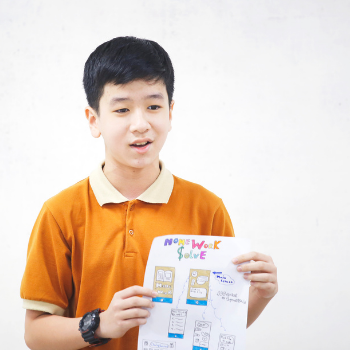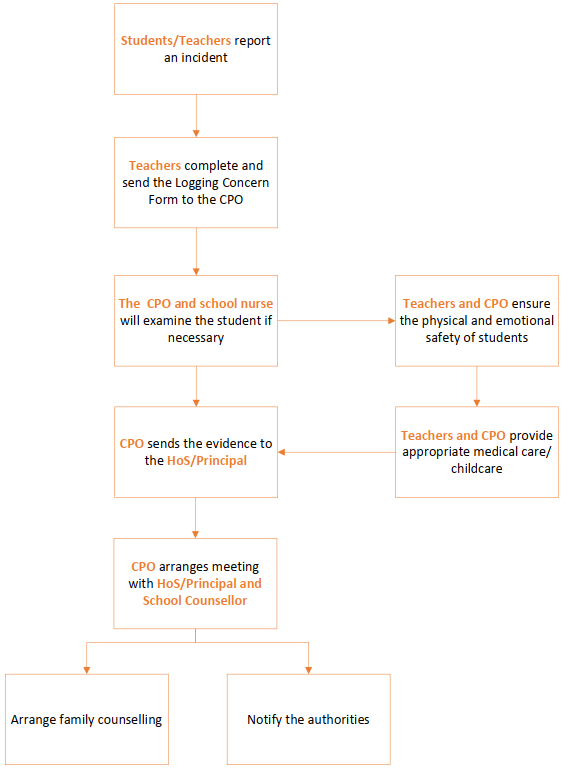Our mission is to create a safe, caring and creative learning environment that inspires all students to grow their talents and characters, so they become well–rounded lifelong learners and compassionate leaders who contribute to change the world for the better.
The UTS Child Protection Policy sets out to outline the actions that will be taken to ensure that all students are properly safeguarded and protected in school and at home. Our policy is based on Safeguarding and promoting the welfare of children, which is defined as:
- Protecting children from maltreatment
- Preventing impairment of children’s health or development
- Ensuring that children are growing up in circumstances consistent with the provision of safe and effective care; and
- Taking action to enable all children to have the best life chances
This policy emphasises the need for good levels of communication between all members of staff and those with designated responsibility for child protection.
At UTS, the Board of Directors and all staff fully dedicate in the effort of safeguarding and protecting children. We recognise that the safety and protection of all students is of paramount importance and that all staff have a full and active part to play in preventing potential risks and protecting students from harm.
We believe that the school is a caring, positive, safe and stimulating educational environment which promotes all students’ social, physical, emotional and moral development. Ultimately, we understand that effective safeguarding of children can only be achieved by putting children at the centre of the educational system, and by every individual playing their full part, working together to meet the needs of all our students.
Research supports the effectiveness of prevention as a primary means of ensuring the safety and security of children, and we are committed to prevention through a variety of means. However, there are circumstances where means of prevention are not sufficient, and the commission of abuse and neglect takes place. In these circumstances, the school and families will collaborate with local agencies and local authorities for the best solution.
The aims of this policy are to:
- Confirm that the students’ development is supported in ways that will foster security, confidence and independence.
- Raise the awareness of teachers, non-teaching staff and volunteers of the need to safeguard children and of their responsibilities in identifying and reporting possible cases of abuse.
- Confirm the structured procedures to be followed by all members of the school community is cases of suspected harm or abuse.
- Emphasise the need for good levels of communication between all members of staff and those with designated responsibility for child protection, health and safety and other safeguarding responsibilities.
- Emphasise the appropriate safeguarding and child protection policies, procedures and arrangements of those service providers who use the school’s premises through extended schools or provide any other before and after-school activities.
- Emphasise the links with the school’s policy for safe recruitment of staff and volunteers, and for managing allegations.
With the aims above, in addition to being responsive in the preventive sense, we must also be prepared to respond in a planned manner and attend to the range of protection issues including abuse in whatever form it may take.
Abuse and neglect are forms of maltreatment of a child.
A person may abuse or neglect a child either directly by inflicting harm, or indirectly, by failing to act to prevent harm. Children may be abused in a family or in an institutional or community setting; by those known to them; or, more rarely, by a stranger. They may be abused by an adult or adults, or another child or children.
There are four popular types of child abuse and neglect:
- Physical abuse
- Sexual abuse
- Emotional abuse
- Neglect
PHYSICAL ABUSE
- Inflicting physical injury on a child by other than accidental means, causing skin bruising, burns, disfigurement, impairment of physical or emotional health, or loss or impairment of any bodily function, death; and/or
- Creating a substantial risk of physical harm to a child’s bodily functioning and/or
- Committing acts that are cruel or inhumane regardless of observable injury.
- Such acts may include, but are not limited to, instances of extreme discipline demonstrating a disregard of a child’s pain and/or mental suffering; and/or
- Assaulting or criminally mistreating a child as defined by either the criminal code or school policy; and/or
- Engaging in actions or omissions resulting in injury to, or creating a substantial risk to the physical or mental health or development of a child.
| POSSIBLE INDICATORS OF PHYSICAL ABUSE
|
SEXUAL ABUSE
- Sexual abuse involves forcing or enticing a child or young person to take part in sexual activities, not necessarily involving a high level of violence, whether or not the child is aware of what is happening.
- The activities may involve physical contact, including assault by penetration (for example, rape or oral sex) or non-penetrative acts such as masturbation, kissing, rubbing and touching outside of clothing.
- They may also include non-contact activities, such as involving children in looking at, or in the production of, sexual images, watching sexual activities, encouraging children to behave in sexually inappropriate ways, or grooming a child in preparation for abuse (including via the internet), often results in victims accepting the blame, responsibility, guilt and shame for the offender.
- Sexual abuse is not solely perpetrated by adult males. Women can also commit acts of sexual abuse, as can other children.
| POSSIBLE INDICATORS OF SEXUAL ABUSE
|
EMOTIONAL ABUSE
- Emotional abuse is the persistent emotional maltreatment of a child such as to cause severe and persistent adverse effects on the child’s emotional development.
- It may involve conveying to children that they are worthless or unloved, inadequate, or valued only in so far as they meet the needs of another person.
- It may include not giving the child opportunities to express their views, deliberately silencing them or ‘making fun’ of what they say or how they communicate.
- It may feature age or developmentally inappropriate expectations being imposed on children. These may include interactions that are beyond the child’s developmental capability, as well as overprotection and limitation of exploration and learning, or preventing the child participating in normal social interaction. It may involve seeing or hearing the ill-treatment of another.
- It may involve serious bullying (including cyberbullying), causing children frequently to feel frightened or in danger, or the exploitation or corruption of children. Some level of emotional abuse is involved in all types of maltreatment of a child, though it may occur alone.
- It may refer to a situation where a child is put in an uncomfortable situation which is inappropriate for both the adult and the child.
| Boys may tend toward more: | Girls may tend toward more: |
|
|
| POSSIBLE INDICATORS OF EMOTIONAL ABUSE
|
NEGLECT
- Physical: failure to provide necessary food or shelter, or lack of appropriate supervision—this would include failure to provide proper adult guardianship such as leaving children unsupervised at home for any extended period of time; and/or
- Medical: failure to provide necessary medical or mental health treatment; and/or
- Emotional: a pattern of actions, such as: inattention to a child’s emotional needs, failure to provide psychological care, or permitting the child to use alcohol or other drugs, specific examples may include verbal humiliation, refusing to acknowledge presence of child, invasion of privacy for no specific reason, violent threats, etc.
- Exposure to domestic violence: Any incident of threatening behaviour, violence or abuse between adults who are, or have been intimate partners or family members. Seeing, hearing or knowing of a parent being abused is traumatic for children, and can have long-term damaging emotional and psychological effects.
| POSSIBLE INDICATORS OF NEGLECT
|
|
What happens when a teacher/ staff has reasonable cause to believe?
These indicators of abuse and neglect will be used by the staff member as a guideline for reporting to on of the Child Protection Officer in the teacher’s school section, who will determine if the case needs further attention. A report must be made when a staff member has reasonable cause to believe that a child has suffered abuse or neglect. All reports are confidential. |
Initial reporting guidelines
Notification of abuse or neglect is required when a person suspects, on reasonable grounds, that a child has been or is being abused or neglected.
Anyone aware of such a situation must report it immediately to the Child Protection Officers in their section of the school for further investigation.
How to respond to a child’s disclosure of abuse
The educator’s role is not to investigate or verify the situation, but rather to make the report and set in motion the process of getting help for the child.
Support of the student is important. In order to do this, the following recommendations are provided:
- Reassure the student that it is okay to tell what happened.
- Staff may ask the student if s/he would prefer to speak to a counsellor
- Tell the student what to expect. If you don’t know, say so, but let the student know s/he can be supported by you.
- Project a calm, understanding and supportive attitude to the students.
- Avoid having the student repeat her/his explanation to different staff.
- Let the student know that you must tell the Child Protection Officer to get help. Explain that you will have to tell another person because s/he is at risk. Use a script such as “If you tell me something that makes me feel that you are unsafe or at risk in any way, then I will need to tell someone else”.
- Reassure the student that it is not his/her fault.
- Make clear, detailed notes of the conversation.
- Respect the student privacy by not discussing the situation out of school.
- After reporting, it is important to maintain a supportive presence for the student.
In addition:
- It is important to understand the importance of early reporting.
- An educator who reports in good faith is protected from civil liability.
- Reporting a disclosure is a request for an investigation.
- Use the Concerns Logging Form to report concerns about students or staff.
- Be specific about the context in which the student disclosed.
- Record notes using the student’s own words – try not to add your own interpretation and judgments (or make separate notes about these).
- Describe any injuries you see. Take the student to the school nurse who should take photos of the injuries, bruises, cuts and or bleeding, and write a report.
- Sign all notes with the date and time as well as name of the signatory.
- Make sure the Concerns Logging Form and any notes are given to the relevant Child Protection Officer and that they are NOT in the student’s regular school files.
Procedure description:
1. The student is referred by a staff or self-refers to a school counsellor.
2. The teacher/counsellor/staff completes a Concerns Logging form and notifies the relevant Child Protection Officer (CPO) of suspected abuse in person or by email, if personal means is not possible.
3. The school nurse, along with the relevant Child Protection Officer, examines the student, documents and takes photographic evidence, where applicable, if it has not already been done.
4. The relevant Child Protection Officer, or the Head of School/Principal where appropriate, each personally receive a written hard copy of the Concerns Logging form.
5. A decision is made by the Child Protection Officer on appropriate action.
6. The procedure to be followed for child abuse cases:
a. Ensure the physical and emotional safety of the student – if the student faces danger by returning to the family, (family abuse) an alternative living arrangement must be made.
b. Assess and provide appropriate medical care.
c. When/if it is safe and appropriate to do so, arrange a meeting with parents, including the Head of School/ Principal, if appropriate, in a timely fashion of the abuse being disclosed
d. At the time of the meeting, the school may arrange counselling and support, via a school-approved psychologist for family therapy.
e. If this recommendation is not followed to the satisfaction of the psychologist, the school and the family, the case will be reviewed to see whether the student is fit to return to an academic environment and whether governmental authorities should be notified.
f. If the above recommendations are still not followed, the case will be reviewed by the Child Protection Officer and could be referred to a list of social services.
g. Only The Child Protection Officer can arrange a Parents Meeting (if deemed appropriate)
7. The Counsellor may meet with the student and continue to provide support, as deemed appropriate, by the psychologist/psychiatrist.
All reports or other actions must be kept confidential.
Each incident of possible abuse should constitute a separate referral.
Legal immunity
The school shall not hold responsible or fault any school employee making a report of abuse that is later judged to be false, unless it can be demonstrated that the person wilfully and intentionally falsified a report. This could include reporting matters concerning members of staff.
The school shall cover any and all legal fees for any staff named in legal action as a consequence of their having made a report of alleged child abuse.
Suspected or confirmed cases of physical and sexual abuse, physical neglect and emotional maltreatment must be reported. The reporter should have reasonable cause or reasonable suspicion to believe that abuse or neglect has occurred. The reporter is not required to have proof. Abuse that took place in the past must be reported as long as the child remains in the home of the abuser or, as long as the child is at risk of further victimisation from the abuser.
The school must be a safe place for all students (Refer to the Health and Safety policy. This covers all aspects of school Health and Safety including fire safety and crisis management, medical concerns, campus resource use)
Doors should where possible have clear glass windows – staff must be visible from outside the room.
Staff bathrooms are available in each within the school. Staff should refrain from sharing bathrooms with students wherever possible.
When a student discloses about inappropriate behaviour of school personnel, the school must respond no differently than if the alleged offender is a parent, relative or other. Staff members have daily access to students and the emotional and physical safety of a student is determined by the access of the offender to the student, thus disclosure of teacher offences must be handled immediately and with seriousness.
The integrity of a school and a system is NOT dependent on whether or not an offender exists; instead, the integrity of the school or system IS dependent on whether and how that school responds when an alleged offender within the school is reported. It is the duty of the Head of the School/Principal to prevent and deter sexual harassment, as well as to provide procedures for the resolution or prosecution of sexual harassment between teacher/employee and child.
An allegation or concern includes witnessing another member of staff behaving towards a child or children in a way which indicates s/he would pose a risk of harm if they work regularly or closely with children.
These procedures apply where an adult who works (paid or unpaid) with children or young people in an education setting has:
- Behaved in a way that has harmed a child or may have harmed a child
- Possibly committed a criminal offence against or related to a child
- Behaved towards a child or children in a way that indicates he or she would pose a risk of harm to children
Stage 1
1. An allegation of concern is reported to the Child Protection Officer, who will discuss with the Head of School/Principal.
2. The student’s parents are informed immediately (depending on the case/perpetrator)
3. Restrictions are placed, if deemed necessary on the teacher’s access to the student, and possibly to all students.
Stage 2
1. The Head of School/ Principal sees the teacher concerned, with a witness.
2. The teacher is isolated from the School, with no access allowed to the school, pending investigation.
3. The Child Protection Officer and/or Head of School/ Principal meets with the teacher, outside the school, if necessary, for further discussion.
4. In light of evidence, the Head of School/Principal decides the appropriate course of action. This could include a Board of Directors’ Hearing.
5. The Head of School/ Principal takes appropriate action. This could include a verbal warning/a formal warning/dismissal/re-instatement.
6. If the allegation is made against the Head of School and/or the Principal, then this matter would be investigated by the Board of Directors.
Stage 3 (External to the school) Should the offender be deemed guilty:
1. The Head of School/ Principal reports the suspected abuse to the police for investigation.
2. The alleged offender is reported to local police station.
3. Where a case has been concluded, a report should be sent to the school and, if appropriate, the offender’s legal authorities.
All staff have a responsibility to report concerns about the professional conduct of colleagues whose behaviour might harm a child. Any concerns that are raised should be listened to fairly and equally with all allegations taken very seriously.
Considerations:
- Apply procedures with common sense & judgement
- If the allegation is about physical contact, the strategy discussion should consider whether ‘reasonable force’ has been used
- All options to avoid suspension should be considered prior to taking that step
- If investigation by the police or children’s social care is unnecessary, the Head of School/Principal should consider further options.
- Resignation/ceasing service provision should not prevent an allegation being followed up
- ‘Compromise agreements’ must never be used
- Cases in which an allegation was proven to be false, unsubstantiated or malicious should not be included in employer references (or in employee file of malicious)
- A phased return and/or the provision of a mentor may be appropriate if staff have been away from work during investigation
The safe recruitment of staff in schools is the first step to safeguarding and promoting the welfare of children in education. At UTS we ensure the practice of safe recruitment in checking and recording the suitability of staff and volunteers to work with children.
Before any teacher is accepted, the following should have taken place:
- Up to date police records from a teacher’s country of origin and previous country of employment, should have been received, if possible, and checked by the school.
- If a teacher has worked in two or more schools within three (03) years, telephone contact should be made with those schools to ask why the teacher is leaving and if there were any concerns of a safety nature with children. This should be done after the receipt of a private and confidential reference from the school(s).
- Read and agreed upon Staff code of conduct.
- Whenever possible, staff are to be interviewed before being appointed and are given the opportunity to disclose any information that would give concern, if they were to work in a school environment.
Standards of behaviour expected of staff, are outlined within the UTS People Handbook. It is expected that all staff read and comply with these standards.
Every year, all staff:
- Should be made aware of the school’s policy and procedures regarding child protection.
- Have regular, mandatory child protection training.
New staff should have child protection training as part of the induction process.
All staff should be aware of the following areas:
- When and where abuse occurs.
- Types of abuse – physical, emotional, sexual abuse and neglect.
- How to respond if they suspect that a child or young person is being or has been abused.
Ensure that all staff who work with children undertake appropriate training to equip them to carry out their responsibilities for safeguarding children effectively and that this is kept up to date by refresher training at three yearly intervals.
Staff who do not have a lead child protection role (which, it explicitly states, must include the Head of School/Principal, where this person is not the designated senior person) should receive such training at least every three years.
Temporary staff, which should include supply teachers, activity providers and volunteers, need to have child protection briefings.
It is the role of the Child Protection team to ensure that he/she receives refresher training at two yearly intervals to keep his or her knowledge and skills up to date.
Activity providers:
- Are required to provide UTS with police checks
- Should submit at least one reference which are checked by the school
- Receive training on the UTS Child Protection Policy
Adults should take care when supervising students on visits and outings, particularly where the setting is less formal than the usual workplace.
Adults are in a position of trust and their behaviour should remain professional at all times.
The owners/managers of establishments used for visits from educational settings are responsible for ensuring that:
- They comply with health and safety regulations
- The setting & equipment is fit, and safe, for purpose
- Their staff are trained in safeguarding and have appropriate background checks
Prior to booking any visit, consider issues for staff and volunteers, including:
- Their suitability
- Have they received appropriate & up to date training
- Do they have up to date background checks
All risk assessments should include:
- Transport issues
- First aid and medication arrangements
- Specific safeguarding issues relating to a student included on the visit, e.g. health, disability, access, support
- If site security and surveillance is appropriate
- Staff to child ratios
- Intimate care and personal hygiene issues
- Fire practice, health and safety issues
- Consideration of other needs of students e.g. gender identity and religious issues
- The suitability of sleeping arrangements for overnight stays e.g. separate rooms for boys and girls and the location of staff bedrooms to ensure adequate supervision
The school visit leader should conduct generic risk assessments relating to any adventure activities they will be doing.
Any safeguarding issues occurring during a visit must be reported to the designated safeguarding lead or deputy immediately.
For all visits:
- Wherever possible undertake a pre-visit to gauge the suitability of the venue before making any arrangements
- If the venue/visit has an element of adventure, or the provider is delivering the activity, additional assurances should be sought from the owner/manager
- The Educational Visits Coordinator must be informed & must obtain permission from:
- The Head of School/Principal for approval for each visit to go ahead
Permission is required from a person with parental responsibility before any child or young person can take part in an educational visit.
What is cyber-bullying?
Cyber-bullying happens ‘online’ through electronic information technology with a widespread audience and numerous devices to communicate through.
Cyber-bullying can leave children and young people feeling scared, upset, isolated and very vulnerable, particularly as the bullying can happen whilst in their own home.
There are a number of different methods of cyber-bullying, but the main ones are:
- Electronic communication such as messages, texts, emails, photographs, video-messaging, sexting via mobile phones, computers, smart-phones, tablets etc to individuals or groups
- Communication is threatening, upsetting or offensive and may include racist, sexist or homophobic content
- Making humiliating and abusive phone calls on mobiles or land lines
- Sending inappropriate communication that can be shared with others through social networking and gaming sites
- Communicating with friends of the victim and other people to try to make them become part of the bullying
- Setting up ‘profiles’ on social networking sites to make fun of a child or young person
- Creating a false identity to impersonate someone and send inappropriate communications in their name
- Use chat rooms and gaming sites to abuse other players, use threats, lock victims out of games, spread false rumours
- Sending viruses or hacking programs that can destroy the victim’s computer or delete personal information from their hard drive
- Posting intimate, sensitive and personal information, about someone without their permission or knowledge
The above methods can also be used by adults to ‘groom’ vulnerable children and young people in order to sexually exploit them. These people pretend to be someone else online in order to be-friend a child or young person, find out sensitive information or obtain intimate photographs of them, and then threaten to expose this information to their family of friends.
| Images of students and other identifying information should be carefully managed; written consent should be obtained from the student and their parents or carers before it is used, and the image should be removed as soon as the student has left the school. |
Assessing and managing risk – the setting should:
- Take reasonable precautions to prevent access by students and staff to inappropriate material
- Maintain an audit of all Information and Communication Technology use at the setting
- Make students aware of strategies for safe and responsible use of the internet and what to do when things go wrong
- Staff should safety-check all sites and links before using with students
- The use of social media should be risk-assessed and carefully controlled within the setting
- ‘Managed’ Learning Environments’ (MLE) must be thoroughly risk assessed and monitored
- A clear reporting process should be in place to deal with problems and all staff and students made aware of it
| Communicating with students, staff, parents and carers/ guardians:
|
All education settings should be safe environments for children and young people to learn.
The purpose of internet use in educational settings is to raise educational standards and promote achievement, support the professional work of staff and enhance the settings’ management of information, communication and administration systems between staff, students and parents or carers.
Therefore, safeguarding children and young people online can involve a range of potential issues such as cyberbullying, extremist behaviour, grooming, child sexual exploitation and sexting.
This highlights the need to educate children, young people, their parents, carers and staff about the benefits and risks of using this environment and provide safeguards and awareness for users to safely control their online experiences.
All settings should have an E-Safety policy that reflects the settings whole-school approach and should operate alongside other policies including:
- Student and staff behaviour
- Bullying
- Curriculum
- Data protection
- Information sharing and security
The UTS Child Protection Policy is based on the 2016 Vietnamese Children’s Law (adopted by the National Assembly of the Socialist Republic of Vietnam on April 05, 2016) and the United Nations Convention on the Rights of the Child (CRC) of which Vietnam is a signatory. Children’s law and policy are of particular importance to our school’s policy.
Vietnamese Children’s Law
These following actions are strictly prohibited:
- Deprivation of children’s right to live.
- Child abandonment, neglect, trafficking, kidnap, fraudulent exchange or capture.
- Sexual abuse, violence, abuse or child exploitation
- Preventing children from exercising their rights and obligations.
The United Nations Convention on the Rights of the Child
Protection from abuse and neglect
The State shall protect the child from all forms of maltreatment by parents or others responsible for the care of the child and establish appropriate social programs for the prevention of abuse and the treatment of victims.
Sexual exploitation
The State shall protect children from sexual exploitation and abuse, including prostitution and involvement in pornography
Contact information:
- National Emergency number on Children protection: 111
- Youth Service and Rights Protection Office HCMC hotline: 1900.54.55.59
- Children protection association HCMC hotline: 1800.90.69
















